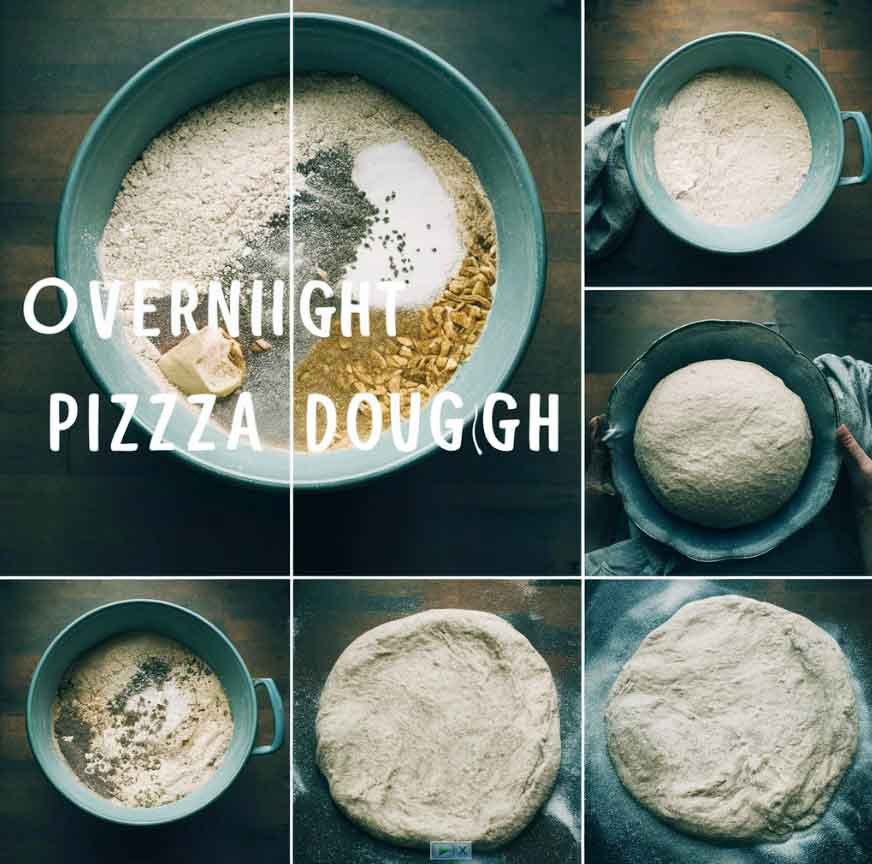
To make overnight pizza dough, combine flour, yeast, water, and salt, then let it rest in the fridge. This slow fermentation enhances flavor and texture.
Crafting the perfect overnight pizza dough is an art that transforms simple ingredients into a culinary masterpiece. Imagine biting into a slice of pizza where the crust is the star, boasting a delicate balance of chewiness and crispness that only a slow-rise dough can achieve.
This method is not just for professional bakers; it’s accessible to home chefs who appreciate the nuanced difference a well-rested dough can bring to their homemade pizza. The anticipation of slicing into your creation after the flavors have melded and matured is truly part of the joy. Let’s embark on this journey of patience and precision, yielding a pizza dough that will elevate your home-cooked pizza to rival that of your favorite pizzeria.
Introduction to Overnight Pizza Dough
Are you ready to elevate your pizza game? Overnight pizza dough is your secret weapon. This method transforms your homemade pizza with incredible flavor and texture. Let’s dive into why letting your dough rest overnight makes such a big difference.
Why Choose Overnight Fermentation?
Choosing overnight fermentation means choosing flavor and texture. This slow process allows the yeast to work gradually, creating a complex taste. The dough becomes easier to handle and shape. It also results in a crust with the perfect balance of crunch and chew.
- Better digestion: Long fermentation makes the dough gentler on your stomach.
- Amazing flavor: Slow yeast activity enhances the dough’s natural taste.
- Enhanced texture: The dough gains strength, leading to a superior crust.
The Magic Of Slow-risen Dough
Slow-risen dough is like a fine wine. It gets better with time. The extended rise allows enzymes to break down complex sugars. This results in a more digestible and flavorsome crust.
| Benefit | Description |
| Flavor Depth | Yeast creates nuanced flavors overnight. |
| Texture Perfection | The dough develops a light, airy structure. |
| Easy Handling | Gluten relaxes, making the dough pliable. |
Gathering Your Ingredients
Embarking on a journey to create the perfect overnight pizza dough starts with the right ingredients. Quality matters as each component plays a pivotal role. Let’s ensure your pantry is stocked with everything you need for a delicious outcome.
The Essentials
For overnight pizza dough, simplicity reigns. You’ll need just a few basic ingredients:
- Water – Acts as the dough’s hydrating agent.
- Yeast – The driving force for fermentation and rise.
- Salt – Enhances flavor and controls yeast activity.
- Oil – Olive oil gives the crust a crisp texture.
Choosing the Right Flour
The foundation of any pizza dough is the flour. Selecting the right type can make a world of difference.
| Flour Type | Protein Content | Best For |
| All-Purpose Flour | 8-11% | Flexible uses, everyday baking. |
| Bread Flour | 12-14% | Chewy, crusty pizza bases. |
| 00 Flour | 11-12% | Authentic, thin pizza crusts. |
For overnight dough, high-protein bread flour is ideal. It ensures a chewy, robust crust able to hold generous toppings.
Mixing the Dough
Let’s dive into the art of making overnight pizza dough. The secret lies in ‘Mixing the Dough’.
Combining the Ingredients
Mixing the dough is a crucial step. Start with the right ingredients. You’ll need flour, yeast, salt, and water. Use a large bowl for enough mixing space. Add dry ingredients first, then pour in the water. Mix slowly until flour absorbs the water. This creates a sticky dough. Knead the dough on a floured surface. Aim for a smooth and elastic texture.
Tip: Use a kitchen scale for precise measurements. This ensures consistency in your dough.
The Importance of Water Temperature
Water temperature can make or break your dough. Use warm water to activate the yeast. Aim for water around 110°F (43°C). Too hot and the yeast dies. Too cold and it won’t activate. Use a thermometer to check the temperature.
Remember: Yeast is alive and needs the right environment to work.
After mixing, cover the dough with a damp cloth. Let it rest overnight in a cool place. By morning, it will have doubled in size. Now, it’s ready for shaping and baking into delicious pizza!

The Kneading Process
Kneading pizza dough is essential. It develops gluten, giving the dough strength and elasticity. For overnight pizza dough, proper kneading ensures a perfect balance of texture and flavor. Let’s explore hand kneading versus using a mixer and learn when to stop kneading.
Hand Kneading Vs. Mixer
Hand kneading is traditional. It allows for a personal touch. You can feel the dough’s texture change under your fingers. It’s a slower process but can be very satisfying.
Using a mixer is faster. It’s consistent and less tiring. A dough hook attachment does the work for you. It’s great for making multiple batches.
- Hand Kneading:
- Start with a floured surface.
- Press and fold the dough for 10-15 minutes.
- Use the heel of your hand for pressure.
- Mixer Kneading:
- Attach the dough hook to your mixer.
- Run on a low to medium setting for 5-7 minutes.
- Watch the dough cling to the hook.
When to Stop Kneading
Stop kneading when the dough is smooth. It should feel slightly tacky, not sticky. A well-kneaded dough springs back when poked. If it holds the indentation, keep kneading.
| Signs to Stop Kneading |
| Smooth surface |
| Slightly tacky feel |
| Springy texture |
A windowpane test can also help. Stretch a small piece of dough. If it forms a thin film before tearing, it’s ready.
Remember, for overnight dough, less is more. Over-kneading can lead to tough pizza crusts. Trust your senses and these tips for the perfect overnight pizza dough.
First Rise: Bulk Fermentation
The first rise, also known as bulk fermentation, is crucial. During this phase, the dough develops flavor and structure. Getting it right leads to the perfect pizza base.
Ideal Conditions For Rising
Temperature and time are key for a successful first rise. The dough thrives at 70-75°F (21-24°C). This range speeds up yeast activity without overheating.
- Warm kitchen spot
- No drafts
- Consistent temperature
Aim for a rise time of 8-12 hours. This long, slow rise enhances flavor and texture.
Covering the Dough
Cover the dough to keep it moist. Use a damp cloth or plastic wrap. This prevents a dry skin from forming on the dough.
Ensure the cover is loose enough to allow the dough to expand. It should not restrict the dough’s growth.
| Cover Option | Benefits |
| Damp Cloth | Reusable, eco-friendly |
| Plastic Wrap | Airtight, maintains moisture |
Check the dough periodically to ensure its rising well and the cover stays in place.
Shaping the Dough
After your overnight pizza dough has risen, it’s time to shape it. This step is crucial. It defines your pizza’s final texture and size. Proper shaping can make or break your homemade pizza experience. Follow these simple steps to create the perfect pizza base.
Creating Perfect Balls
Once the dough has doubled in size, it’s time to divide and conquer. Flour your hands and surface. Gently press the dough to release air. Cut the dough into equal portions. Aim for a smooth surface as you shape each piece into a ball. This creates a uniform crust.
- Divide the dough into equal parts.
- Press to release air bubbles.
- Shape each piece into a tight ball.
Resting Before the Final Rise
After shaping the dough balls, they need a short rest. This allows the gluten to relax. Your dough will stretch more easily. Cover the balls with a clean cloth. Let them rest for 30 minutes. This ensures a smooth final rise. Your crust will be airy and light.
- Cover dough balls with a cloth.
- Rest for 30 minutes.
- Prepare for final rise and stretch.
Overnight Fermentation
Overnight Fermentation is a game-changer for pizza enthusiasts. This process allows the dough to develop deep flavors and perfect texture. By letting the dough rest overnight, it undergoes a slow rise. This enhances its characteristics, making for an unforgettable pizza experience. Let’s explore how temperature affects this process and why taking your time can yield the best results.
Refrigerator vs. Room Temperature
Choosing the right spot for fermentation is crucial. The refrigerator offers a cold environment. It slows down yeast activity. Room temperature, on the other hand, provides a warmer setting. It speeds up the process. Each has its benefits:
- Refrigerator: Longer rise, more flavor development
- Room Temperature: Quicker rise, still tastier than fast-rising dough
For best results, use the refrigerator. It extends the fermentation. This results in a complex flavor profile and a superior crust texture.
Why Patience Pays Off
Good things take time, and pizza dough is no exception. An overnight rest allows the gluten in the dough to relax. This makes the dough easier to shape. It also gives the dough a chance to form more nuanced flavors. These are the rewards of patience:
- Better texture and chewiness
- Enhanced flavors from slow fermentation
- Less work when stretching the dough
Remember, the longer the dough ferments, the better your pizza will taste. Let the dough rest overnight. Enjoy a pizza that rivals your favorite pizzeria.

Baking Your Pizza
Transforming your overnight pizza dough into a delectable masterpiece is an exciting journey. The secret lies in the baking process. Achieving that ideal crispy crust with a perfectly cooked topping is the ultimate goal. Let’s explore the crucial steps to bake your pizza to perfection.
Preheating Your Oven
The road to pizza excellence begins with a hot oven. Preheating is crucial for a crisp crust. It ensures immediate heat contact, which is essential for baking.
- Turn your oven to its highest setting.
- Wait until the temperature reaches the set level.
- Place a pizza stone or baking sheet inside early.
- This prepares your baking surface for the dough.
The Final Stretch: Baking To Perfection
Now comes the crucial moment. Your dough is ready, toppings are set, and the oven is roaring. It’s time to bake!
- Slide the pizza onto the preheated stone or sheet.
- Set a timer to avoid overcooking.
- Watch as the edges brown and cheese bubbles.
- Check the bottom for a golden hue.
- Remove and let it cool slightly before slicing.
Perfectly baked pizza boasts a crispy crust with melted toppings. Each bite is a blend of flavors, textures, and aromas. Enjoy your homemade creation!
Frequently Asked Questions
What Is Overnight Pizza Dough?
Overnight pizza dough is a type of dough that ferments slowly, typically over 12-18 hours, resulting in a flavorful and well-developed crust when baked.
How Long Should Pizza Dough Rest?
Pizza dough should rest overnight, ideally for at least 12 hours, to allow for proper fermentation and flavor development.
Can Pizza Dough Rise Too Long?
Yes, pizza dough can over proof if left to rise for too long, leading to a dough that may become too airy and lose structure.
What Flour Works Best For Pizza Dough?
High-protein bread flour is ideal for pizza dough, as it provides the necessary gluten strength for a chewy, crisp crust.
Does Overnight Dough Need Refrigeration?
Overnight pizza dough should be refrigerated during its slow fermentation to control the yeast activity and develop the flavor.
Conclusion
Crafting the perfect overnight pizza dough is simpler than you might think. With the right ingredients and a bit of patience, you’re set for success. Remember, practice makes perfect. So, don’t hesitate to experiment. Every effort brings you one step closer to achieving that dreamy, crispy crust.
Happy baking!



